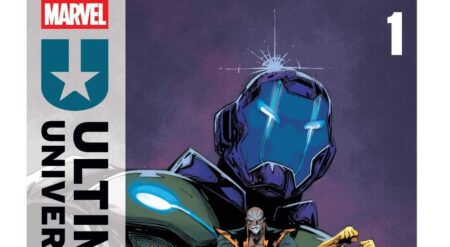
Damage Control #1 is the first in a new comedy series published by Marvel Comics, written by Adam F. Goldberg and Hans Podionoff, with art by Will Robson, colors by Ruth Redmond, and letters by Clayton Cowles. The second story is titled “Zapped and the Mother of Invention,” written by Charlotte McDuffie, with art by Jay Fosgitt, colors by Redmond, and letters by Cowles. Damage Control has changed, and the building is now a hub for heroes and powerful items. When a new employee is added to the mailroom, he has to learn the ropes soon. And in the backup story, an employee takes his mother for a tour before she finds something she shouldn’t.
The new function of Damage Control might benefit from a calm explanation so that the story can be understood. That is not what happened in this issue. A brief explanation of what Damage Control has become is given to Gus but does not adequately prepare anyone for what is inside that headquarters. Gus is installed in a small position in the company, but there is so much suddenly going on. There is either heaps of exposition as the story slows down, or it accelerates into chaos. Inside Damage Control are dozens of cameos from superheroes, but what they are doing there is a mystery. The frantic speed and embracing chaos is fine, but there must be rules to break them. When there is drama, we don’t actually see it as the real action is confined within the offices. But this rush to sort the situation leads to a joke that easily loses speed and becomes boring quickly. While the tone is learned and the expectation that anything can happen is set, I don’t think I knew anything about the organization or the story by the end of Damage Control #1.
The fun that this comic generates is through the potential for cameos. Any hero can appear, as figures from all corners of the Marvel Universe. Seeing Moon Knight, Man-Thing, and a horde of other characters appear is exciting, and some of the jokes demonstrate Goldberg’s talent. Knowing what they are, therefore, isn’t entirely necessary. That’s part of the comedy, but the sheer amount of them may lead to an overflow of enjoyment. The other characters involved in the comic are those employed by Damage Control. It is very early, and the issue had a lot to get through, but personalities are one-dimensional at this stage. Where some tongue-in-cheek jokes about working in an office job, much of the dialogue is awkward, too long, or actually quite boring, which is bizarre in a comic full of excitement.
The art is also odd, matching everything else about the series so far. All the cameos mean that there are several that Robson has to draw, and most of them look fantastic. Moon Knight’s hood is great as it casts a shadow on the mask below, and the flames on Ghost Rider’s head have incredibly specific details. She-Hulk has even more exaggerated muscles than other artists may grant her. But the way capes hang over shoulders can be too busy, and some expressions don’t look right either. There are some periods with excellent visual humor, and the panel layouts can get through a montage with clever methods.
The colours are tremendous. One big splash page reveals a host of characters, and the shades and tones on all of them are perfect. What Redmond excels at is keeping the backgrounds a consistent color, such as dark green, then making important objects rich and vibrant. It helps look out for easter eggs and references, of which there are numerous in this issue. The standard lettering is easy to read, but there are some increased sizes for word balloons that become infuriating and tiresome to read.
There is a backup story that follows the absurd tone of the comic but with an entirely different story. It’s an energetic and genuinely funny story as a mother is touring around the HQ. The art is adorable and unique, almost creating the cartoonish nature of this story by itself.
Damage Control #1 is a bit too weird. It is easy to understand what Goldberg was trying to accomplish with this first issue, but it sticks the landing horribly. You can’t get a foothold when the story moves too fast, but when it slows down the explanations are repetitive yet ultimately empty. Having heroes appear for gags is brilliant, and many of them fit, but the comic lacks focus everywhere else. The dialogue often suffers from being overwritten and gets bogged down. It’s a disappointing new start, leaving the next issue with a mountain to climb.
Damage Control #1 is available now wherever comics are sold.
Rating: 2.5/5
Damage Control #1
TL;DR
Damage Control #1 is a bit too weird. It is easy to understand what Goldberg was trying to accomplish with this first issue, but it sticks the landing horribly. You can’t get a foothold when the story moves too fast, but when it slows down, the explanations are repetitive yet ultimately empty.






